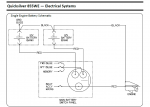peterjaw
Well-Known Member
Good day, captains,
My Quicksilver 855 weekend comes with 2 batteries, battery 1 and battery 2.
There is a battery switch that I can select battery 1, battery 2, battery 1+2, and OFF.
My dealer tells me to alternatively use battery 1 and battery 2, which means use battery 1 this time, battery 2 next time, and so on....
For avoid messing up, I use battery 1+2 currently.
My question is, during normal operation which position should I switch to? On the user's manual, it says in emergency situation, switch to 1+2. I wonder what kind of emergency situation is it talking about?
Thanks for your help.
ps. I have no idea which battery is for house and which is for engine, neither does the dealer.
My Quicksilver 855 weekend comes with 2 batteries, battery 1 and battery 2.
There is a battery switch that I can select battery 1, battery 2, battery 1+2, and OFF.
My dealer tells me to alternatively use battery 1 and battery 2, which means use battery 1 this time, battery 2 next time, and so on....
For avoid messing up, I use battery 1+2 currently.
My question is, during normal operation which position should I switch to? On the user's manual, it says in emergency situation, switch to 1+2. I wonder what kind of emergency situation is it talking about?
Thanks for your help.
ps. I have no idea which battery is for house and which is for engine, neither does the dealer.



